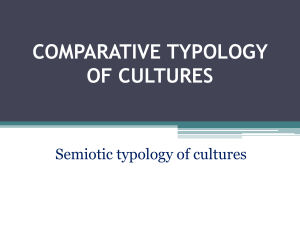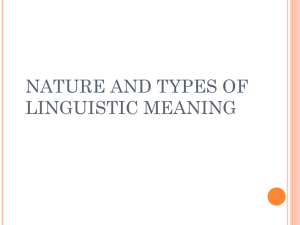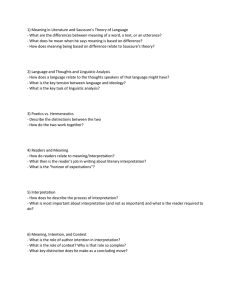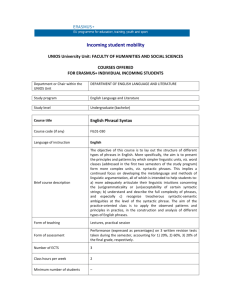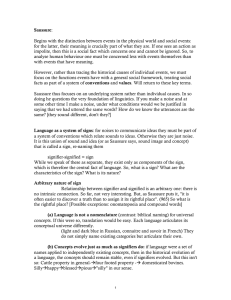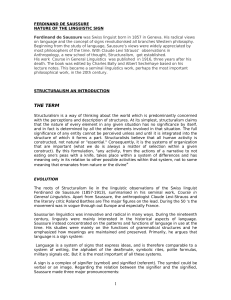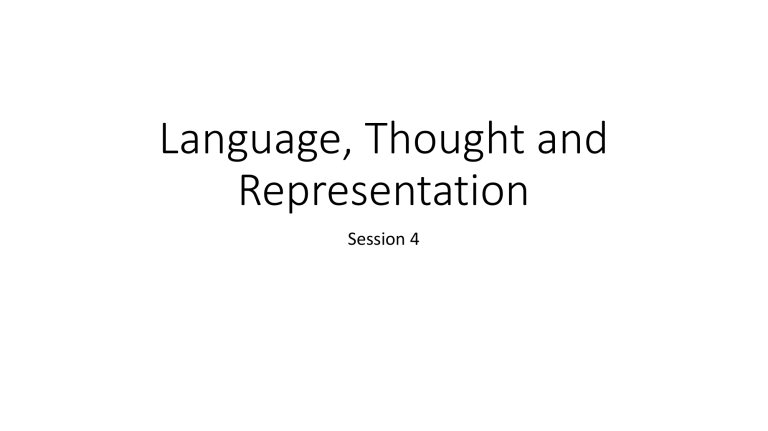
Language, Thought and Representation Session 4 LANGUAGE AS A SYSTEM OF REPRESENTATION (I) • Language is a way of representing reality. How? • Is language merely a reporting device? Or does it influence the way we think about reality? • Language enables us to label and categorize the world around us. The first language we learn through cultural transmission provides us initially with a ready-made system of categorizing the world around us. • Can you think of an example in which you revised your ideas about a thing or cultural norm from the one you previously held by virtue of being a member of a society? Ferdinand de Saussure’s Theories • Ferdinand de Saussure (1857–1913) is often known as the founder of modern linguistics. • Saussure approaches theory of language from two different perspectives. On the one hand, language is a system of signs. That is, a semiotic system; or a semiological system as he himself calls it. On the other hand, a language is also a social phenomenon: a product of the language community. • Sign, signifier and the signified WORD=SIGN WORD=SIGN Ferdinand de Saussure’s Theories • Sign, signifier and the signified • Langue and Parole • The system and rules of langue can change. These changes are very slow, and may take hundreds of years. Individuals start using a new word, or an existing word in a new way (all these usages are parole), and other language users understand and adopt this. When this new linguistic behaviour is well established, we can say that the new form has become part of langue, one that we all understand. (49) • The Symphony • Synchronic vs. Diachronic • Let’s watch a video here. LANGUAGE AS A SYSTEM OF REPRESENTATION (II) • It is tempting to believe that there is a fixed relationship between the set of words we have learned (our categories) and the way external reality is organized. • However, evidence from the world’s languages would suggest that the organization of external reality actually varies to some extent according to the language being used to talk about it. • Some languages may have lots of expressions for types of “rain” or kinds of “coconut” and other languages may have only one or two. • The Color Spectrum: Although the Dani of New Guinea can see all colors of the spectrum, they only use names for two of them Observing this difference in basic color terms in languages, we can say that there are conceptual distinctions that are lexicalized (“expressed as a single word”) in one language and not in another. • Kinship Terms DOES LANGUAGE REPRESENT REALITY? • Because of the arbitrary relationship between signifier and signified, and because signs take their meaning from their relationship to other signs, there is no single way for languages to describe reality. We can call this linguistic diversity.(59) • What is Edward Sapir and Whorf’s term for this diversity? THE SAPIR-WHORF HYPOTHESIS The Sapir Whorf hypothesis states that one there is a relationship between language and thought known as linguistic relativity and to that language determines thought known as linguistic determinism. These are two hypotheses. Let’s unpack them one by one. DOES LANGUAGE REPRESENT REALITY? • The Sapir-Whorf hypothesis proclaimed the influence of language on thought and perception. This, in turn, implies that the speakers of different languages think and perceive reality in different ways and that each language has its own world view. The issues this hypothesis raised not only pertain to the field of linguistics but also had a bearing on Psychology, Ethnology, Anthropology, Sociology, Philosophy, as well as on the natural sciences. For, if reality is perceived and structured by the language we speak, the existence of an objective world becomes questionable, and the scientific knowledge we may obtain is bound to be subjective. • Such a principle of relativity then becomes a principle of determinism. Whether the language we speak totally determines our attitude towards reality or whether we are merely influenced by its inherent world view remains a topic of heated discussion LINGUISTIC RELATIVISM • We not only talk, but to a certain extent probably also think about the world of experience, using the categories provided by our language. Our first language seems to have a definite role in shaping “habitual thought,” that is, the way we think about things as we go about our daily lives, without analyzing how we are thinking. LINGUISTIC DETERMINISM There is a stronger version of this idea, of linguistic relativism which holds that “language determines thought.” If language does indeed determine thought, then we will only be able to think in the categories provided by our language. For example, English speakers use one word for “snow,” and generally see all that white stuff as one thing. In contrast, Eskimos look out at all the white stuff and see it as many different things because they have lots of different words for “snow.” So, the category system inherent in the language determines how the speaker interprets and articulates experience. Examples: • Color words • Hopi conception of time POLITICAL CORRECTNESS • Politically correct speech became a matter of hot debate in the 1980s, when many native speakers of English became sensitive to biased terms and phrases that exist in the language. In the previous decade, activists of the feminist movement made the first attempts to diminish differences between men and women in society. • Feminists criticized the existing language and culture as “maledominated” and “patriarchal.” The history of society, as the feminists argued, was written from the male point of view (“it’s HIStory, not HERstory”) POLITICAL CORRECTNESS: Don’ts Sexist language is a term that labels the use of male-dominated phrases suggesting that members of one sex are less able, intelligent, and skillful. Pejorative language is the use of words or phrases disapproving or suggesting that something is no good or of no importance (labeling nationalities, aged people, etc.); taboo language includes words or phrases which are likely to offend somebody—certain words referring to sex or sexual organs, excretion, and people’s nationality or race can be particularly offensive. POLITICAL CORRECTNESS: Characteristics • Inclusive language suggested avoiding the use of male pronouns in the cases when the gender of a person is unknown. • In the late 1980s, the rules of political correctness (PC) began to be applied to a broad range of issues—such as race, age, sexual orientation, abilities. As people became sensitive to bias on the basis of race, gender, age, and sexual orientation, they tried to minimize the negative impact of language that reflected these biases. The tendency toward “deracialization” in English provided new names for nationalities and ethnic groups. • The words Negro, colored, and Afro-American were replaced by African American; Oriental or Asiatic became Asian or more specific designations such as Pacific Islander, Chinese American, Korean. Indian, a term that refers to people who live in or come from India, was differentiated from terms used for the native peoples of North America such as American Indian, Native American, or more specific terms like Chinook or Hopi. Task 1 The following phrases use sexist language. Rewrite them to make them inclusive. 1. A teacher should be tolerant with his students. 2. A child needs the love of his parents. 3. An actress is usually nervous before the show. 4. Mary is a camerawoman. 5. The committee elected a chairman. 6. Man is destroying our planet. 7. Today man-made fibers are used for manufacturing stockings. 8. This substance is not known to man. Task 2 Although well known, the following proverbs are not politically correct. Try to change them. 1. Early to bed and early to rise makes a man healthy, wealthy, and wise. 2. He who cannot obey cannot command. 3. A man’s home is his castle. 4. Every man has his hobbyhorse. 5. He is happy that thinks himself so. Task 3 Many people are sensitive about their abilities, age, culture, and appearance. Make the following phrases sound inoffensive to the persons being spoken about. 1. She is looking after her insane mother. 2. The program offers long-term care for the elderly and immediate care for the mentally retarded. 3. A new clinic for the care of geriatrics is being proposed. 4. He is as blind as a bat. 5. My neighbor is as deaf as a post. TASK 3 1. She is looking after her mentally challenged mother. 2. The program offers long-term care for senior citizens and immediate care for the developmentally challenged. 3. A new clinic for the care of older people is being proposed. 4. He is visually challenged. 5. My neighbor has hearing impairments. 6. Jane finds it difficult to express her feelings. 7. Overweight people need to go on diets.
